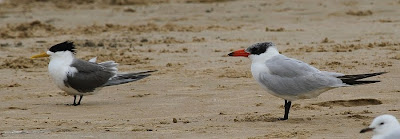


Little

Big

Bigger

Biggest! The four tern species I saw were Little, Common, Greater Crested and Caspian.

Common and Greater Crested were the most frequently-encountered.

I found the Commons a pretty confusing bunch.



There didn't seem to be much consistency in head pattern...

...or leg colour

... or bill length

And trying to work out the moult just gave me a headache! On this adult everything looks nice and fresh except the outer primaries.

This one seems to have fresh primaries but worn coverts (and a very worn head?) which makes it perhaps 1st summer/2nd winter?

And how old is this bird? First winter-type plumage pattern but primary moult and extremely worn median coverts - so another '2nd winter'? I'm struggling here - so if anyone can explain, please do so!

I've no idea what's going on here. Looks like there are three age classes of primaries - 1-2 being the newest, then 3-5, 6 is missing, and 7-10 are old. I can only guess this is something to do with Common Terns' habit of 'suspending moult before migration and then carrying on again once they arrive at the non-breeding grounds. I've read that Common Terns may moult their primaries three times a year!


A couple more for you to work out!

Greater Crested Terns were generally much easier, being all dolled up for breeding. This is a long shot of the colony at the Nobbies, Phillip Island.

Of course there were also a few subadults taking life easy!


But most were busy trying to look their best

or else looking after the kids!
No such hard work for the Caspians.



Their job is just to hang around and make all the other terns look small!


2 comments:
Nice! I enjoyed your tour of some of the Terns. I have trouble with most of them myself.
Hi, some wonderful shots, and glad to see you struggling like me with some of our summer Common Terns. Would you mind numbering the photos so I can make some comments and we can hopefully both learn something from our discussion?
cheers,
Jill Dening
Sunshine Coast, Queensland
Post a Comment